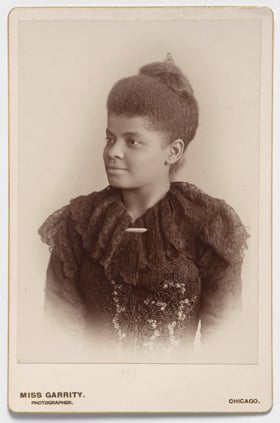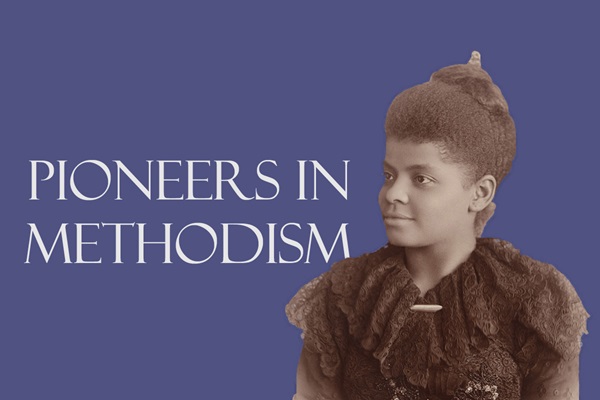In celebration of Black History and Women’s History months, Ask The UMC remembers four of the pioneering and groundbreaking Black women in U.S. Methodist history in a two-part series.
Part 1 celebrates Ida Bell Wells-Barnett and Mary McLeod Bethune.
Part 2 celebrates Rev. Sallie Crenshaw and Bishop Leontine T.C. Kelly.

Learn More
- Ida B. Wells-Barnett (Arlisha Norwood, National Women’s History Museum)
- Ida B. Wells-Barnett and Her Passion for Justice (Lee D. Baker, Duke University)
- Ida B. Wells (National Park Service)
Ida Bell Wells-Barnett (1862-1931)
Ida Bell Wells was born into slavery in Holly Springs, Mississippi, in the midst of the U.S. Civil War. She would go on to become a pioneering journalist, anti-lynching activist, suffragist and crusader for justice for women and people of color.
After emancipation, her parents were active in the Freedmen’s Aid Society of the Methodist Episcopal Church, which established Rust College, the oldest of the historically Black colleges and universities. Ida began her advanced education at Rust College, however, the death of her parents and a younger brother from a Yellow Fever outbreak in 1878 led her to leave college and take a job as a teacher to support her siblings.
One of the results of Reconstruction in the South had been integration of all public facilities, including transit. Not all transit companies complied, however. In 1884, while seated in a “ladies car” (for which she had purchased a ticket) on a train bound for Memphis, she was asked to move to a smoking car to accommodate a white woman. She refused. When the conductor started to drag her from the car, she bit him. She was ultimately forcibly removed from the train. She sued the railroad, initially winning her case, but losing it on final appeal in the Tennessee Supreme Court. The story made headlines and helped launch her journalism career. The 25-year-old schoolteacher who sued a railroad company became a sought-after writer.
In 1889, she became a partner in Free Speech and Headlight, a Memphis newspaper with wide circulation among Black and Christian audiences. This launched another career focus: the investigation, exposure and crusade to end lynching in the South. Following the lynching of three friends in Memphis, Wells-Barnett wrote arguably her most important work, “Southern Horrors: Lynch Law in All Its Phases.”
Her fearless criticism of lynching forced her to leave Memphis in 1892 for a less dangerous home base in Chicago. There, she worked alongside Jane Addams to block segregation in Chicago’s public schools and was one of the most seasoned veterans in the fight for women's suffrage. During the landmark 1913 national suffrage parade in Washington, fellow suffragists asked Wells-Barnett not to walk alongside them, fearing alienating white support. But when a mob overtook the parade route and began beating women marchers, Wells-Barnett rejoined her fellow suffragists in the chaos.
While Chicago would be her home for the rest of her life, she remained highly sought-after nationwide as a speaker, mentor and organizer with pro-suffrage, pro-civil rights and anti-lynching organizations. She also became one of the two Black female co-founders of the NAACP — though considered by many to be too radical to hold leadership. She remained active in urban reform in Chicago until her death in 1931.

Mary McLeod Bethune (1875-1955)
Mary McLeod Bethune was one of the most significant educators, leaders, government officials and advocates for civil rights of the 20th century.
Learn More
- Mary McLeod Bethune (Dr. Debra Michaels, National Women’s History Museum)
- Methodist Women’s History: Mary McLeod Bethune (UMC.org video)
- Education and Equality: The Work of Mary McLeod Bethune (United Methodist Women)
- Mary McLeod Bethune (General Commission on Archives and History)
One of the youngest of 17 children, she was born in South Carolina to former slaves.
Completing her education at Scotia Seminary and the Moody Institute for Home and Foreign Missions, McLeod had intended to become a missionary. However, no one would send her as a missionary, so she focused her efforts on education and teaching school. She married another teacher, Albertus Bethune.
After the end of that marriage, McLeod Bethune started her own educational institution, a school for girls in Daytona, Florida, that would, in 1931, merge with Cookman Institute and become Bethune-Cookman University. The quality of education offered there, combined with McLeod Bethune’s leadership in advocacy and youth organizations, gained the attention of the Roosevelt White House. In 1936, she was appointed the director of Negro Affairs of the National Youth Administration, a position she would hold until 1944.
In addition to her legacy in education, McLeod Bethune actively campaigned for civil rights and fought to end discrimination and lynching.
While in government service, she became vice president of the NAACP in 1940, an office she would continue to occupy until her death in 1955. She was responsible for overseeing the integration of the Women’s Army Corps in 1942, and, under President Truman in 1945, was appointed as the only Black woman to be present at the founding of the United Nations. She was a successful businesswoman in the hospitality and insurance industries.
As a Methodist leader, she was a lay delegate to General Conference four times, advocating for the elimination of the segregated Central Jurisdiction.
This content was produced by Ask The UMC, a ministry of United Methodist Communications.





